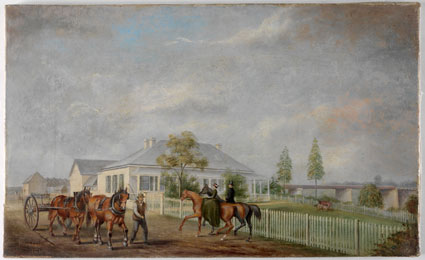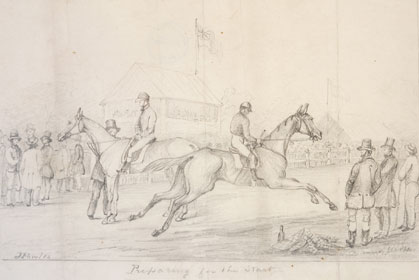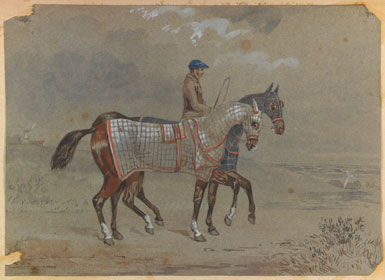They're racing
As Sydney's suburbs sprawled outward, it became necessary to relocate the racecourse to the town perimeter several times. Soon other racecourses were being established to the east and west of the city and across the country. Nearly every country town had its own jockey club whose regular meetings formed an important part of the social and business activities of the surrounding district.
Emu Hall, Penrith, 1866, by Joseph Fowles
Oil painting ML 1009
Race meetings continued to be held at Hyde Park until 1826, when the Sydney Racecourse was moved out to Governor Bligh's old property, 'Clarendon', just off Parramatta Road at Camperdown.
The Australian Racing and Jockey Club was formed in 1828 and held its first meeting at Parramatta in October of that year. The Australian Jockey Club (AJC) was formed in 1842, and thereafter all the principal Sydney race meetings were held at the Homebush Racecourse, on land supplied by William Charles Wentworth.
Preparing for the start, c.1850, by Joseph Fowles
Pencil drawing DG SSV*/Gen/5
Racing at Homebush ceased with the re-establishment, in 1860, of Randwick Racecourse, still Sydney's premier racing venue. First sanctioned for horseracing by Governor Richard Bourke on 28 January 1833, convict labour had cleared the track which was later forced to close when colonial racing languished during a severe economic depression.
In about 1845, another racecourse was set up on land immediately opposite the Woolpack Inn (now the Bald Faced Stag Hotel), on Parramatta Road at Leichhardt. Prepared for the hotel's licensee, Thomas Shaw, the course extended back to the present railway line, with a grandstand situated in Railway Street. The Petersham Races were promoted by Shaw, assisted by subscriptions from well known Sydney sportsmen of the day.
Prize money is often referred to as a 'purse'. Few people realise that the term actually derives from the purse in which the prize money (usually gold coins such as sovereigns) was stored. Racing prizes were usually represented as 'a Lady's purse', and such purses were often made by female associates of the racing fraternity.
The first colonial steeplechase was held on 19 September 1844 at Five Dock Farm, the property of Mr J. Abercrombie. The course had nine leaps including a pond leap of 25 feet and a 41-foot stone fence. It was a free public event and attracted a large crowd including the Governor, Sir George Gipps.
Groom exercising two horses near the sea, c.1850, H. Alken attrib.
Watercolour PXC 286/1/11
> View entire album Analysis of the Hunting Field by Henry Alken and other sketches by various artists, ca. 1845-1889 ![]()
The Hawkesbury Stakes was the first race on the program, carrying a purse of 50 sovereigns and sweepstakes of ten sovereigns. There were three contestants: Highflier, British Yeoman and Block.
Block was the favourite and led the field over the first jump, a three rail fence. At the brook, Block faltered and just missed giving his rider a wetting, landing him on the edge of the bank. Undaunted, the jockey remounted and made for the greatest obstacle of the course, the solid stone wall which his adversaries had already cleared. Block baulked at this obstruction, apparently not fully recovered from the previous fall, and required much encouragement of the whip to get him over. As the horses headed down the straight, British Yeoman had a lead of about ten lengths over Highflier, with Block coming a bad third. From that point, however, Block showed his staying power and, amid much excitement, overtook his rivals to win the first steeplechase run in the colony.







